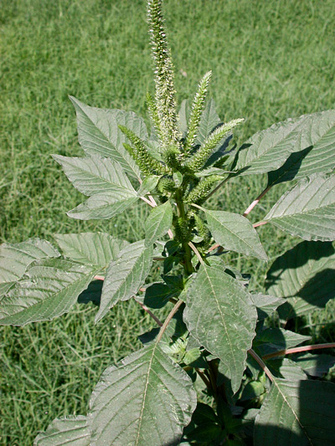« Prev Next »
Palmer pigweed (Amaranthus palmeri) haunts the fields of many farmers around the nation. It grows more than six centimeters a day, can reach a stunning height of 2.5 meters, and can produce up to 600,000 seeds in its lifetime. Not to mention its notoriously tough stem that makes it nearly impossible for farming equipment to uproot.

Prior to the age of selective herbicides and GMOs (Genetically Modified Organisms), farmers fought weeds with tillage and hand weeding. However, tillage of large fields was both time-consuming and detrimental for the environment because it left valuable topsoil exposed to wind and water erosion. A more viable solution was imperative, and this came with the advent of Monsanto’s glyphosate active herbicide patent in the 1970s. Large-industrialized crop farmers around the world were finally able to control their unwanted weed populations. Sure, there were other herbicides before glyphosate, such as triazine, but those herbicides easily contaminated groundwater and harmed wildlife species through runoff waste. Roundup was a miracle chemical for farmers. It was able to kill a broad spectrum of weeds, and it was able to break down quickly to reduce its environmental impact.
Initially, glyphosate, or better known for its commercial name Roundup, was introduced as a nonselective herbicide (one that can kill all plants) before it became a narrow-spectrum or selective herbicide (one that kills a targeted weed). Once Roundup became a selective herbicide in 1990, sales took off as Monsanto created its Roundup Ready crops that were genetically modified to tolerate the chemical. Glyphosate herbicides kill plants by blocking the EPSPS enzyme, an enzyme involved in the synthesis of plant amino acids and vitamins. There are several ways in which a plant can be genetically modified to be tolerant to glyphosate. A widely used strategy is to incorporate a soil bacterium gene that produces a glyphosate-tolerant form of EPSPS. The incorporation of glyphosate-tolerant crops allowed farmers to spray their fields to kill weeds while leaving their crops unharmed. Today, Roundup Ready crops account for nearly 90 percent of soybeans and 70 percent of corn and cotton grown in the United States. However, Monsanto’s genetically modified crops have been notoriously nicknamed as terminator seeds because they are sterile. Each year, farmers must purchase the most recent strain of seed from Monsanto to continue using glyphosate herbicides.

In the words of Mike Owen, a weed scientist at Iowa State University, what we’re seeing is Darwinian evolution in fast-forward. Herbicide resistance is widely recognized as the result of adaptive evolution of weed populations to the selection pressure exerted by glyphosate herbicides. The least herbicide-sensitive plants have a selective advantage in weed populations with heavy doses of herbicides. Thus, they are able to increase in frequency and establish a population shift towards a population of herbicide-resistant plants.
Even though the race for new herbicides to replace glyphosate is on, weed scientists argue that the golden solution of glyphosate herbicides is too valuable to be thrown away. It is estimated that the total amount of United States farmland afflicted with Round-up resistant weeds is relatively small. Most scientists agree that farming in a post-Roundup age will be costly and inefficient. Farmers must revert to crop rotations, cultivations, tillage, and limited herbicide usage. However, if farmers across the nation do their part by rotating crops constantly and using various herbicides, this will slow the development of glyphosate-resistant weeds over time.
References:
Delye, C. et al. Deciphering the evolution of herbicide resistance in weeds. Cell 29, 649-658 (2013).
ISAAA. Herbicide Tolerance Technology: Glyphosate and Glufosinate (2014).
MIT.edu. About Roundup Ready Crops (2009).
MIT.edu. The Roundup Ready Controversy (2009).
Nature. A growing problem (2014).
Nature. War on weeds loses ground (2012).
Neuman, W. & Pollack, A. "Farmers Cope with Roundup-Resistant Weeds." The New York Times. May 30, 2010.
Phys.org. US 'superweeds' epidemic shines spotlight on GMOs (2014).
ScienceDaily. Farmers Relying on Herbicide Roundup Lose Some of its Benefit (2009).
Image Credits:
1. The Amaranthus palmeri Image is by Wikipedia user Pompilid and is distributed via Wikimedia Commons under a CC-BY license.
2. The Consecutive steps of herbicide action figure is from Deciphering the evolution of herbicide resistance in weeds by Christophe Delye, Marie Jasieniuk, and Valerie Le Corre and is distributed by Cell.com.






















